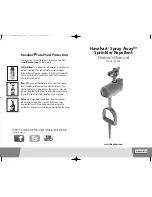
807
Thermo G
8 Repair
position and mount the stand (4) to the vehicle using
screws, nuts and washers according to the mounting
points used.
2. If necessary, secure the exhaust line using a clamp to
the exhaust outlet (3).
3. Fit coolant the hoses onto the coolant inlet (5) and the
coolant outlet (6) and secure them with hose clamps
applying a tightening torque of 6 ± 0.6 Nm.
4. If available, open the water taps.
5. Install the burner head (see 8.4).
6. Bleed the coolant circuit (see 8.14.1).
8.12 Heater removal and installation
NOTE:
The fuel supply system must be subsequently
bleeded (see 8.14.1).
Removal
1. Remove burner head (see 8.4).
2. Remove heat exchanger (see 8.11).
Installation
1. Install heat exchanger (see 8.11)
2. Install burner head (siehe 8.4)
3. Bleed coolant circuit (see 8.14.1).
8.13 Gas pressure regulator removal and
installation
Work on the gas supply pipe and the gas pressure
regulator may only be performed by personnel with
an official authorization.
ATTENTION:
Before removing the gas pressure regulator, make
sure that the gas supply from the gas reservoir to the
gas pressure regulator is shut-off.
Removal
1. Unplug electrical connectors at the gas pressure
regulator.
2. Close coolant hoses using pinch-off pliers.
NOTE:
Optionally mark coolant hoses for proper installation.
3. Loosen the hose clamps securing the coolant hoses
and remove the hoses.
4. Remove the gas intake line.
5. Loosen the hose clamps securing the gas outlet line
and remove the line.
6. Remove the hose from the safety valve.
7. Loosen the nut at the threaded attachment pin and
remove the gas pressure regulator together with the
washer and spring washer.
Installation
1. Place gas pressure regulator together with the washer
and spring washer into installation position and attach
it using the nut (tightening torque 20 ±2Nm).
2. Reconnect the hose to the safety valve.
3. Reconnect the gas outlet line and secure it using a
hose clamp (tightening torque 5 +0.5Nm).
4. Mount gas intake line (tightening torque 25 Nm).
5. Reconnect coolant hoses and secure them using
hose clamps (tightening torque 1.2 Nm).
6. Remove the pinch-off pliers from the coolant hoses.
7. Restore electrical plug connections.
ATTENTION:
After installation of the gas pressure regulator and
before starting the heater the gas intake line connec-
tion should be checked for tightness by authorized
personnel.
8.14 Start-up after installation of burner
head, heater or heat exchanger
During the test run the coolant and fuel connections must
be checked for leak-tightness and tight fit.
If the heater goes while operating in an error mode,
perform a troubleshooting (see Chapter 5).
8.14.1 Bleeding of the coolant circuit
NOTE:
The coolant circuit must be principally bleeded
according to manufacturer‘s specification.
Risk of scalds at coolant with increased temperature.
The Aquavent 5000 (U4814) and Aquavent 6000S
(U4855) circulating pumps may only be switched on for
bleeding, after dry operation can be excluded.
The Aquavent 5000S (U4854) and Aquavent 6000SC
(U4856) circulating pumps may even in dry operation be
switched on for bleeding.
Adjust the vehicle heating system to "warm" and refill
coolant.
As soon as it is confirmed that the vehicle engine is filled
with coolant, run vehicle engine with increased idle speed.
Once the cooler thermostat opens, switch the vehicle
Danger to life and health!
Warning!
Risk of scalds!
Caution!







































